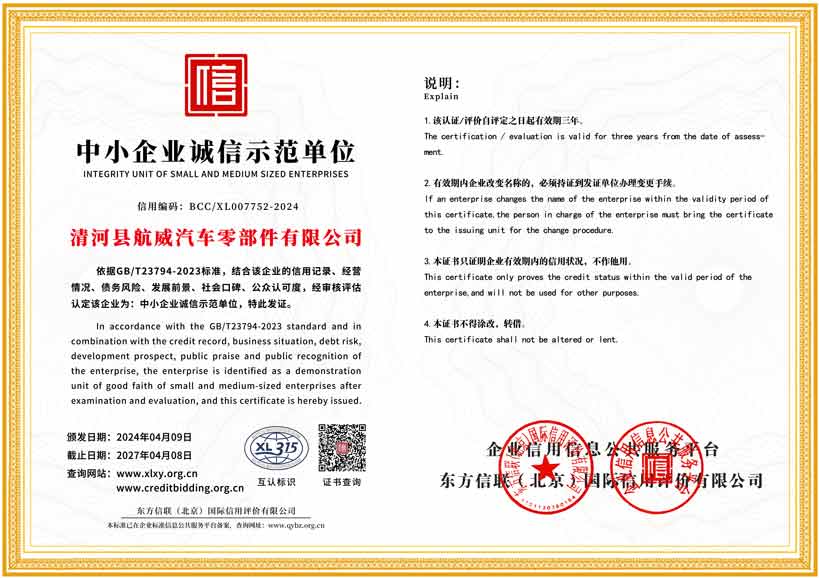clutch fluid pipe
Understanding Clutch Fluid Pipes A Key Component in Vehicle Performance
Clutch fluid pipes are essential components in many vehicles, playing a critical role in the operation of the clutch system. These pipes are responsible for transporting hydraulic fluid from the master cylinder to the slave cylinder, allowing for the seamless engagement and disengagement of the clutch. Understanding their function and maintenance is crucial for both vehicle enthusiasts and everyday drivers.
The Role of Clutch Fluid Pipes
The clutch system operates using hydraulic principles where the force exerted by the driver on the clutch pedal is transmitted through hydraulic fluid. When the clutch pedal is pressed, the master cylinder generates pressure that is conveyed through the clutch fluid pipes to the slave cylinder. The slave cylinder, located near the clutch assembly, receives this pressure and activates the clutch mechanism, allowing for gear changes without grinding or stalling the engine.
Clutch fluid pipes are typically made from materials such as rubber or metal and are designed to withstand high pressure generated during operation. A well-functioning clutch fluid pipe ensures that the hydraulic fluid remains uncontaminated and at the appropriate pressure, which is vital for optimal clutch performance.
Importance of Maintenance
Like any other component of a vehicle, clutch fluid pipes must be regularly inspected and maintained to avoid performance issues. Over time, these pipes can develop leaks due to wear and tear, which can lead to a drop in hydraulic pressure. A decrease in pressure can cause the clutch to become unresponsive, leading to difficulties in shifting gears and potentially resulting in costly repairs.
Routine checks for signs of wear, such as cracks, fraying, or leaks, can help catch problems early. Additionally, it's essential to check the hydraulic fluid levels regularly. If the fluid appears dirty or contaminated, it is a sign that the system may need flushing and refilling with new fluid to prevent damage to the entire clutch system.
clutch fluid pipe

Signs of Issues with Clutch Fluid Pipes
Drivers should be vigilant about recognizing the signs of potential issues with their clutch fluid pipes. Some common indicators include
1. Unresponsive Clutch Pedal If the clutch pedal feels unusually soft or goes all the way to the floor without engaging the clutch, it may be due to air in the hydraulic system or a leak in the clutch fluid pipes.
2. Fluid Leaks Puddles of clear or slightly colored fluid under the vehicle can indicate a leak in the clutch fluid pipes, requiring immediate attention.
3. Difficulty Shifting Gears A challenging or grinding experience when shifting gears often points to inadequate hydraulic pressure, potentially stemming from faulty clutch fluid pipes.
4. Burning Smell A burning odor while driving may suggest the clutch is overheating, which can occur if hydraulic pressure isn't adequately maintained due to a leak.
Conclusion
Clutch fluid pipes are integral to the performance of a vehicle's clutch system, facilitating smooth gear transitions and overall driving comfort. Regular maintenance can prevent significant issues and enhance the longevity of the vehicle’s transmission system. By understanding the role and importance of these pipes, drivers can ensure their vehicles perform optimally, avoiding unwanted repairs and enhancing road safety. Proper care and attention to these seemingly small components can result in a huge difference in the performance and reliability of a vehicle.
-
Workings of Clutch Pipe and Hose SystemsNewsJun.04,2025
-
The Inner Workings of Hand Brake Cable SystemsNewsJun.04,2025
-
The Secrets of Throttle and Accelerator CablesNewsJun.04,2025
-
The Hidden Lifeline of Your Transmission Gear Shift CablesNewsJun.04,2025
-
Demystifying Gear Cables and Shift LinkagesNewsJun.04,2025
-
Decoding Clutch Line Systems A Comprehensive GuideNewsJun.04,2025
